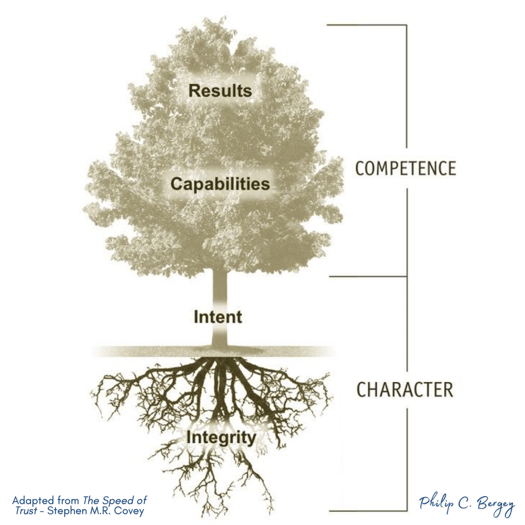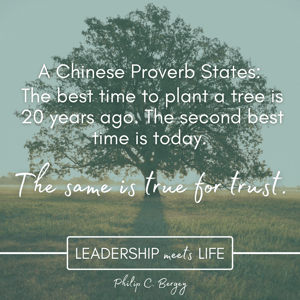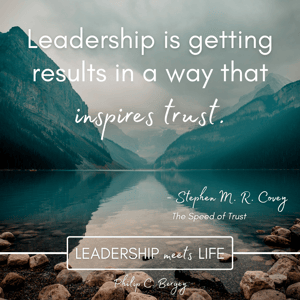
Stephen M.R. Covey, son of Stephen R. Covey, who wrote The Seven Habits of Highly Effective People, wrote The Speed of Trust: The One Thing That Changes Everything.
In The Speed of Trust, the younger Covey makes the case that nothing is as fast as the speed of trust.
Consider Covey’s economics of trust shown in the following formula:
.png?width=525&name=122821_Phil%20Blog%20-%20Economics%20of%20Trust%20(1).png)
Simply stated, less trust means slower progress at a higher cost. Conversely, higher levels of trust mean faster progress at a lower cost.
But what is trust, actually?
A dictionary definition of trust is “firm belief in the reliability, truth, ability, or strength of someone or something.”
Each of us has experienced trust and a lack of trust. We extend and benefit from trust every day. Even assuming that oncoming traffic will stay in its respective lane is a daily exercise in trust. There are many layers of trust in life.
Covey lays out five waves of trust, but in this blog, we will focus mainly on the second wave:
- Self-Trust
- Relationship Trust
- Organizational Trust
- Market Trust
- Societal Trust
You know what builds or diminishes trust in your leadership and life from your own life. Covey is clear that trust results from both character, in the form of integrity and intent, and competence, in the form of capabilities and results.

The first wave—self-trust—establishes the personal credibility that lays the foundation of all trust.
This first wave of self-trust involves:
- Integrity – Are you congruent?
- Intent – What’s your agenda?
- Capabilities – Are you relevant?
- Results – What’s your track record?
Covey then clearly and practically explains how character and competence manifest in 13 behaviors that underlie the second wave of relationship trust.
Character is shown in the following five behaviors:
- Behavior #1: Talk Straight
Be honest. Tell the truth. Let people know where you stand. Use simple language. Call things what they are. Demonstrate integrity. Don’t manipulate people or distort facts. Don’t spend the truth. Don’t leave false impressions. - Behavior #2: Demonstrate Respect
Genuinely care for others. Show you care. Respect the dignity of every person and every role. Treat everyone with respect, especially those who can’t do anything for you. Show kindness in the little things. Don’t fake caring. Don’t attempt to be ‘efficient’ with people. - Behavior #3: Create Transparency
Tell the truth in a way people can verify. Get real and genuine. Be open and authentic. Air on the side of disclosure. Operate on the premise of “What you see is what you get.” Don’t have hidden agendas. Don’t hide information. - Behavior #4: Right Wrongs
Make things right when you’re wrong. Apologize quickly. Make restitution where possible. Practice “service recoveries.” Demonstrate personal humility. Don’t cover things up. Don’t let pride get in the way of doing the right thing. - Behavior #5: Show Loyalty
Give credit freely. Acknowledge the contributions of others. Speak about people as if they were present. Represent others who aren’t there to speak for themselves. Don’t bad-mouth others behind their backs. Don’t disclose others’ private information.
Competence is shown in the following five behaviors:
- Behavior #6: Deliver
 Results
Results
Establish a track record of results. Get the right things done. Make things happen. Accomplish what you’re hired to do. Be on time and within budget. Don’t overpromise and underdeliver. Don’t make excuses for not delivering. - Behavior #7: Get Better
Continuously improve. Increase your capabilities. Be a constant learner. Develop feedback systems—both formal and informal. Act on the feedback you receive. Thank people for their feedback. Don’t consider yourself above feedback. Don’t assume today’s knowledge and skills will be sufficient for tomorrow’s challenges. - Behavior #8: Confront Reality
Address the tough stuff directly. Acknowledge the unsaid. Lead courageously in conversation. Remove the “sword from their hands.” Don’t skirt the real issues. Don’t bury your head in the sand. - Behavior #9: Clarify Expectations
Disclose and reveal expectations. Discuss them. Validate them. Renegotiate them if needed and possible. Don’t violate expectations. Don’t assume that expectations are clear or shared. - Behavior #10: Practice Accountability
Hold yourself accountable. Hold others accountable. Take responsibility for results. Be clear on how you communicate how you’re doing—and how others are doing. Don’t avoid or shirk responsibility. Don’t blame others or point fingers when things go wrong.
Covey believes three additional behaviors involve both character and competence:
- Behavior #11: Listen First
Listen before you speak. Understand. Diagnose. Listen with your ears—and your eyes and heart. Find out what the most important behaviors are to the people you’re working with. Don’t assume you know what matters most to others. Don’t presume you have all the answers—or all the questions. - Behavior #12: Keep Commitments
Say what you’re going to do, then do what you say you’re going to do. Make commitments carefully and keep them. Make keeping commitments the symbol of your honor. Don’t break confidence. Don’t attempt to “PR” your way out of a commitment you’ve broken. - Behavior #13: Extend Trust
Demonstrate a propensity to trust. Extend trust abundantly to those who have earned your trust. Extend conditionally to those who are earning your trust. Learn how to appropriately extend trust to others based on the people’s situation, risk, and credibility (character and competence). But have a propensity to trust. Don’t withhold trust because there is risk involved.
 Covey builds on the collection of the 13 behaviors above, showing how together they manifest in three additional waves of trust: organizational, market, and societal. I intend to pick these three up in a future blog post.
Covey builds on the collection of the 13 behaviors above, showing how together they manifest in three additional waves of trust: organizational, market, and societal. I intend to pick these three up in a future blog post.
If you enjoyed Covey’s Speed of Trust summary, you might also enjoy Charles Feltman’s The Thin Book of Trust: An Essential Primer for Building Trust at Work.
Click here to listen to my Leadership Meets Life podcast episode in which I address the topic of trust, including additional references to Feltman’s work.

- Who do you really trust?
- What do they model that helps you trust them?
- Which of the 13 behaviors matter most to you when working with someone you need to trust?

In the first half of 2022, I’ll be exploring the impact of neuroscience on leadership and life. Stay tuned!

- The Speed of Trust: The One Thing That Changes Everything by Stephen M.R. Covey
- The Thin Book of Trust: An Essential Primer for Building Trust at Work by Charles Feltman.
Let me know how you’re connecting with the Leadership Meets Life Blog and Podcast. I’d love to hear from you! You can reach me directly at philb@designgroupintl.com or by visiting my website.
/Philip%20C.%20Bergey%20Headshot%20(300x300).png)
December 28, 2021
.png?width=100&name=Phil%20Bergey%20Headshot%20(1).png)





Comments